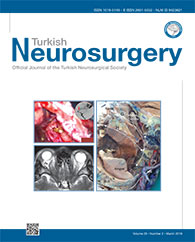2Erciyes University, School of Medicine, Department of Neurosurgery, Kayseri, Turkey
3Memorial Hospital, Department of Neurosurgery, Kayseri, Turkey DOI : 10.5137/1019-5149.JTN.23319-18.2 AIM: To compare the clinical and radiological results of dural splitting and duraplasty in patients with Chiari Type I Malformation.
MATERIAL and METHODS: This study includes 113 adult patients with Chiari Type I malformation treated between 2009 and 2013. The patients were divided into two groups according to the surgical method (Group 1: dural splitting, Group 2: duraplasty). Neurological examinations and magnetic resonance imaging (MRI) scans were recorded periodically on 3rd, 6th,and 12th months at the postoperative period. The tonsillo-dural distance (TDD) and regression rate of the syrinx cavity were measured on T1 and T2 weighted sagittal MRI scans at the postoperative period.
RESULTS: The ratio of syrinx regression was %49.6 in the Group 1 and %54.6 in the Group 2. This result was statistically significant. The TDD increased in Group 2 and this result was statistically significant (p<0.05). Postoperative pain and numbness decreased in both groups and no statistically significant difference was detected.
CONCLUSION: There was no relationship between tonsillar herniation length and the width of syringomyelic cavity. The syrinx cavity more regressed in the group 2 than group 1. There was no relation between the TDD and the ratio of syrinx regression.
Keywords : Chiari type I malformation, Duraplasty, Dural splitting




